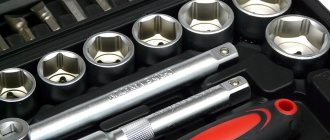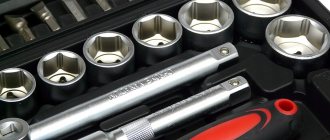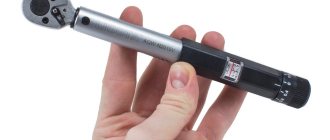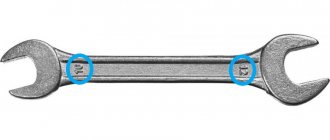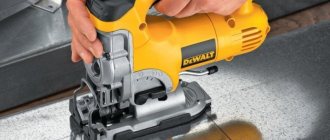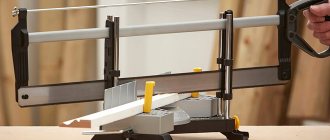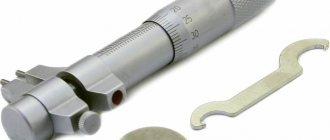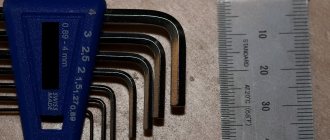Standard sizes of open-end wrenches
Any tool has its own characteristics and parameters. There are also generally accepted standard sizes of open-end wrenches. To determine the size , you need to pay attention to the span of the part that its motionless jaws have. This is the so-called throat of the instrument. The handle of any open-end wrench has a digital marking. This is the size in millimeters that determines the width between the jaws.
Standard sizes can range from minimum (2.5x3.2 mm) to maximum (70x80 mm).
These are acceptable GOST standards that cannot be violated under any circumstances. GOST also specifies other characteristics of open-end wrenches, for example:
- A special calculation of the maximum deviations of the pharynx size is carried out;
- Any manufactured open-end wrench must have specified strength and hardness;
- The trademark marking is established;
- The decorative and protective coating of the key, etc. is taken into account.
Types of keys
Now let's look at what varieties there are.
The most commonly used wrenches have two jaws. Another name for it is a double open-end wrench (GOST 2839). If you need to unscrew a fastener with a mag of 18 or 20 mm between opposite edges, then you need to choose a tool with a handle on which the designations 18 and 20 are located. It happens that in force majeure circumstances a tool of the required size is not always at hand. In this case, a key one size larger is suitable . When using a tool that is not suitable for its intended purpose, you need to use a knife or screwdriver, install them in an empty space.
Types of horn instruments:
- composite (GOST 16.983). Their design contains an end structure nozzle, a hollow socket and a handle, short or long;
- adjustable (GOST 7275.75). These are open-end wrenches where the size can vary;
- narrow profile keys. These are specific keys for a certain type of activity;
- There are star, Bristol and hex keys (GOST 11737.93) that are used to work with bicycle and computer equipment, with screwing in fasteners in hard-to-reach places that border almost on jewelry work.
Basic requirements for tools
For a quality device there are a number of requirements:
- the surface of the instruments is smooth, with anti-corrosion treatment, there are no cracks or kinks on it; parallel jaws without distortions;
- working profile without chips, hardening, or other mechanical damage;
- combination and ring wrenches have uniform ring sizes and a strictly central location of the holes;
- the existing rotation toggle switch is firmly fixed in the ratchet;
- All markings are applied and readable.
The working profile of tools means a combination of planes that impart mechanical pressure from a locksmith tool to the element that needs to be unscrewed.
The body of the wrench is the body of the product that transmits the mechanical effect. Individual characteristics characterize a particular object.
For open-end wrenches, GOST strictly regulates the standard size. It is determined by the gap cavity between the jaws - the mouth of the key. This parameter is measured in millimeters and is recorded in special reference tables. Markings are applied to the body. In the description of such wrenches, GOST requires an indication of the size, hardness, and surface coating material. There is a wide range of key sizes: the minimum is 2.5 millimeters, the largest is 75 mm. Number systems.
Read also: What kind of wood is a smokehouse made from?
One of the characteristics also concerns the size of the tool. Some world manufacturers, on a German initiative, show data on indicators of working elements based on the European (metric) structure. Many others use US inch. The conflict between the systems manifested itself in the coincidence of only two dimensions - 15 mm (19/32′′) and 19 mm (¾′′).
Depending on the calculation system, accessories are divided into two categories:
- Those that support the metric system. The size is given in millimeters and varies between 2.5-230 mm for general kits, 6-41 mm for automotive ones.
- Inch tools work in a system with the main measure inch (1′′ = 25.4 mm). Dimensions range from 1/8 to 91/8′′. For car open-end wrenches, GOST sizes range from 1/8 to 15/8′′.
How to choose an open-end wrench?
How to choose the right tool so that it meets all GOST standards? The variety of models shows that there are different types of products for every need. You need to consider the purpose of its use and the complexity of the task you set for it. The material used for the production of modern nut products is special tool steel ; it consists of an alloy of vanadium and chromium.
There is also one unique tool that will help solve all problems at once, and eliminate the need to think about which open-end wrench to choose.
There are universal models that contain all products at the same time. This tool can handle nuts of various sizes with all types of heads.
It does not slip on a smooth surface due to its powerful teeth, which is its main advantage. There are also electric keys, the name speaks for itself. This tool can be powered by battery or batteries. Therefore, each home craftsman himself determines which products are best suited for him.
The price category is quite varied. Most often, the price depends on the versatility of the technical characteristics and the manufacturer. The cheapest is a single-sided horn instrument, where the open mouth has 3.1–85 millimeters.
When purchasing, you also need to remember about the long handle , which can limit the amplitude of movement of the key when turning. If one of the jaws is shortened, then, naturally, the radius of the wrench increases. In this case, you will be able to place the head on the side of the nut. If the handle is artificially enlarged, the applied force increases, and the jaw jaws will separate or even break. A hammer will be able to help set them in place when spreading, but the material will not be as strong as before. When you have a product made of 40xFA or 40x steel, then there is a method of hardening the sponge.
There is another option on how to repair a broken or worn out pharynx.
By welding the metal layer, you can adjust the volume of the throat using an abrasive tool.
When the open gap is more than 25 mm, then this option for restoring the product will be the most effective. The service life of carob products can range from a year to five. When talking about durability, they always mean a ring wrench (GOST 2906). It cannot be crushed, but it can wear out. There are restrictions on the use of this type of key. It can only be used if it is put on the nuts, but it cannot be used to unscrew, for example, union bolts of flexible hoses. The advantage is the hexagonal or twelve-sided jaw, which makes it possible to carry out work more intensively.
Ratchet wrench
Some models of end and cap type are equipped with a ratchet mechanism (ratchet). An added advantage is the ability to throw the tool. And the small angle required for turning makes screwing and unscrewing the nuts much easier. Ratchet designs vary in the number and size of teeth. To rotate a tool with 72 teeth, 5° is enough, 40 teeth - 9° .
This is very helpful in cramped working conditions. It has one drawback - the ratchet often breaks due to excessive load. Such a tool is much more expensive.
Mass types of keys
Touching on the topic of wrenches, an unforgettable image of an open-end wrench appears before your eyes. The nuts are fixed using lips that look like horns. This is where the name comes from. The second name for such means is used by GOST - open-jaw wrench. The center lines of the handle and head most often intersect at an angle of 15-20 degrees. When manipulating in tight spaces, this configuration will make the work easier. The angles between the axes of the head and handle are made in different sizes; opposite heads have different slopes from each other. Horn models are typically divided into various modifications:
- Double-sided instruments have two jaws of different dimensions. Usually their size designations are adjacent (18−19 mm). The jaws can have different thicknesses: thin ones work in hard-to-reach places, while thick ones are used for loosening nuts made of soft materials.
- For one-sided ones, the body is lengthened in order to increase the moment of force when interacting with fasteners. It is used in assembly production for operations with the same type of nuts. Some models have a locking shank for tube extensions.
- High-speed with a modernized working profile and a shortened jaw for high-speed movement of the key from one element to another. The rotation changes when the tool is turned one hundred and eighty degrees.
- Profile cuts on the lips of open-end wrenches increase the number of contact points and shift the location of the boundaries of the fastening components relative to the jaw. The turning force does not damage the structure in the planes of the nut or in the heads of the bolts, and allows you to unscrew deformed elements.
- A wrench with a working profile in the form of a ring, which is put on the mounting surface, is called a spanner. They can have rings at both ends of the working plane. There are edges along the inner diameter. There are six or twelve of them. The hex power tool unscrews tight, soured connections easily and without damage. Twelve-sided is used when working space is limited. The working profile can be made elongated for the use of attachments. The undoubted advantage of the attachment tool is the permissibility of exerting a large force on the unscrewing planes and working in cramped areas. The weak point is discomfort when working with threads of increased length.
- Devices that have a horn-type head on one end and a cap or end-type head on the other are classified as combined. Their heads are the same size on both sides. The dimensions of the body length are different: when space is limited - shortened standard increasing forces - elongated ones creating the maximum peak of pressure - extra long.
- A tool with a variable working profile is called an adjustable tool. The transformation occurs due to a screw mechanism or slider, which moves the moving part to the required width. The clamping of the fixing parts is not tight, which leads to the rolling of the edges. A plus is the possibility of using it with nuts of various diameters.
Materials for production
According to existing requirements, wrenches must be manufactured using tool steel, an alloy of chromium and vanadium or similar. It must be solid material. The information is reflected in the labeling.
Imported tools contain the following designations: Cr (chrome steel), CrV (chrome vanadium alloy), CrM (chrome molybdenum alloy), CrMoV (chrome molybdenum vanadium steel), etc. GOST recommends that domestic manufacturers prefer chromium-containing steel grade 40X with good strength for the manufacture of open-end wrenches . Usually this is enough for the majority of actions with keys. For high-strength products, chrome vanadium alloy 40 HFA is used. The best instruments are made from grade 45 metal.
Chinese and unidentified keys are sometimes labeled Drop Forget Steel. These accessories are made by forging from unalloyed steel, which means they are fragile and will fail at the wrong time.
Buy GOST 2839-80 - paper document
with hologram and blue seals. more details
We have been distributing regulatory documents since 1999. We punch checks, pay taxes, accept all legal forms of payment without additional interest. Our clients are protected by law. LLC "CNTI Normocontrol"
Our prices are lower than other places because we work directly with document providers.
Delivery methods
- Express courier delivery (1-3 days)
- Courier delivery (7 days)
- Pickup from the Moscow office
- Russian Post
Applies to open-end wrenches with dimensions from 2.5x3.2 to 75x80 mm.
The validity period has been lifted: Gosstandart Decree No. 2426 dated July 24, 1989
Methods for determining key diameter
Universal tools are designed in such a way that there is no need to select the right wrench size. Their working units independently adjust to the diameter of the nut. But there are copies on sale, the range of settings of which is not suitable for working with the diameter of the existing fasteners. In this case, it is worth knowing how to determine and select the size. There are two effective methods.
Read also: 1 week of pregnancy after conception
According to the thread diameter of the part
For a hex nut, a tool should be taken with a diameter that corresponds to the distance between the parallel edges of the nut itself. In order not to use a caliper or ruler in measurements, this value can be calculated from the diameter of the fastener thread. Such data is contained in the technical documentation, which is attached to the bolts and nuts by the manufacturer.
For standard thread diameters, two head sizes are given - reduced and normal. The first option is rare. The size chart for wrench tools is presented below:
- wrench 7 – bolt 4 mm;
- by 8 – 5 mm;
- turnkey bolt 10 has a thread diameter of 6 mm;
- 8 mm – tool No. 13;
- 10 mm – at 17;
- 12 mm – at 19;
- 14 mm - by 22.
And so on.
Determining the turnkey size by the diameter of the bolt head
The second method is no less informative, but you need to use additional tools. As already mentioned, the size of the wrench corresponds to the distance between the two parallel edges of the nut. If there is no information about this value, then you should take a millimeter ruler, or better yet a caliper, and measure this distance. When using a straight edge, remember that it must be applied exactly through the center point of the bolt head. It is not always possible to do this correctly, so the most reliable result will be given by a caliper. The turnkey bolt size will correspond to the tool number.
Hex nut: how to determine the size of the key for it?
In the world of mechanical engineering and when creating devices, you cannot do without bolts with a cylinder-shaped head. But for fixing them, it is the hex key that is suitable, which is controlled at an angle. There are certain standards according to which threads are created.
| Thread, M | M4 | M5 | M6 | M8 | M10 | M12 | M14 | M16 | M18 | M20 | M22 | M24 | M27 | M30 | M33 | M36 |
| Key size, mm | 3 | 4 | 5 | 6 | 8 | 10 | 12 | 14 | 14 | 17 | 17 | 19 | 19 | 22 | 24 | 27 |
Choosing the correct wrench size for the bolt
The ideal material for making keys is tool steel, which is based on high-carbon alloys. Products are obtained from blanks by processing on milling machines followed by burnishing. But such an instrument is considered rare and is not cheap. More often on sale you can find simpler keys, made in line production by casting or stamping.
Depending on the size of the gap between the jaws, wrenches are conventionally divided into three groups:
- Small ones are intended for unscrewing and screwing fastening devices with dimensions up to 10-12 mm.
- The middle group includes instruments with sizes ranging from 12 mm to 22 mm.
- Large devices are considered to be devices for bolts and nuts with a diameter of 22 mm and above.
In order not to make a mistake when choosing a tool, you can use ready-made data from standard tables. For example, from this one:
| WRENCH SELECTION TABLE | |||||||||
| METRIC PROFILE | UNF/UNC PROFILE | ||||||||
| Thread size | A/F key size | Opening key | Thread size | A/F key size | Opening key | ||||
| (mm) | min (mm) | max (mm) | (inch) | min (inch) | max (inch) | ||||
| M 1.6 | 3.2 | 3.22 | 3.28 | 1/4 | 7/16 | 11.18 | 11.33 | ||
| M 2.0 | 4.0 | 4.02 | 4.12 | 5/16 | 1/2 | 12.80 | 12.95 | ||
| M 2.5 | 5.0 | 5.02 | 5.12 | 3/8 | 9/16 | 14.38 | 14.55 | ||
| M 3.0 | 5.5 | 5.52 | 5.62 | 7/16 | 5/8 | 15.98 | 16.15 | ||
| M 4.0 | 7.0 | 7.03 | 7.15 | 1/2 | 3/4 | 19.18 | 19.38 | ||
| M 5.0 | 8.0 | 8.03 | 8.15 | 9/16 | 13/18 | 20.78 | 20.98 | ||
| M 6.0 | 10.0 | 10.04 | 10.19 | 5/8 | 15/16 | 23.98 | 24.21 | ||
| M 7.0 | 11.0 | 11.04 | 11.19 | 3/4 | 1 1/8 | 28 75 | 29 01 | ||
| M 8.0 | 13.0 | 13.04 | 13.24 | 7/8 | 1 5/16 | 33.53 | 33.81 | ||
| M10.0 | 17.0 | 17.05 | 17.30 | 1 | 1 1/2 | 38.30 | 38.61 | ||
| M 12.0 | 19.0 | 19.06 | 19.36 | 1 1/8 | 1 11/16 | 43.08 | 43.38 | ||
| M 14.0 | 22.0 | 22.06 | 22.36 | 1 1/4 | 1 7/8 | 47.88 | 48.21 | ||
| M 16.0 | 24.0 | 24.06 | 24.36 | 1 3/8 | 2 1/16 | 52.68 | 53.04 | ||
| M 18.0 | 27.0 | 27.08 | 27.48 | 1 1/2 | 2 1/4 | 57.45 | 57.84 | ||
| M 20.0 | 30.0 | 30.08 | 30.48 | 1 3/4 | 2 5/8 | 67.03 | 67.46 | ||
| M 22.0 | 32.0 | 32.08 | 32.48 | 2 | 3 | 76.61 | 77.09 | ||
| M 24.0 | 36.0 | 36.10 | 36.60 | 2 1/4 | 3 3/8 | 86.18 | 86.72 | ||
| M 27.0 | 41.0 | 41.10 | 41.60 | 2 1/2 | 3 3/4 | 95 76 | 96 34 | ||
| M 30.0 | 46 0 | 46 10 | 46 60 | 2 3/4 | 4 1/8 | 105.33 | 105.97 | ||
| M 33.0 | 50.0 | 50.10 | 50.60 | 3 | 4 1/2 | 114.91 | 115.57 | ||
| M 36.0 | 55.0 | 55.12 | 55.72 | BS (Whitworth standard) | |||||
| M 39.0 | 60.0 | 60.12 | 60.72 | BS thread size | A/F key size | The closest correct A/F key size | |||
| M 42.0 | 65.0 | 65.12 | 65.72 | ||||||
| M 45.0 | 70.0 | 70.12 | 70.72 | C | (inch) | (mm) | (inch) | (mm) | |
| M 48.0 | 75.0 | 75.15 | 75.85 | 1/4 | 3/16 W | .445 | 11.30 | 7/16 | 12 |
| M 52.0 | 80.0 | 80.15 | 80.85 | 5/16 | 1/4 W | .525 | 13.33 | 17/32 | 14 |
| M 56.0 | 85.0 | 85.15 | 85.85 | 3/8 | 5/16 W | .600 | 15.24 | 19/32 | 16 |
| M 60.0 | 90.0 | 90.15 | 90.85 | 7/16 | 3/8W | .710 | 18.03 | 23/32 | 18 |
| M 64.0 | 95.0 | 95.15 | 95.85 | 1/2 | 7/16 W | .820 | 20.83 | 13/16 | 21 |
| M 68.0 | 100.0 | 100.15 | 100.85 | 9/16 | 1/2 W | .920 | 23.37 | 15/16 | 24 |
| M 72.0 | 105.0 | 105.20 | 106.00 | 5/8 | 9/16 W | 1.010 | 25.65 | 1 | 26 |
| M 76.0 | 110.0 | 110.20 | 111.00 | 3/4 | 11/16W | 1.200 | 30.48 | 1 1/4 | 31 |
| M 80.0 | 115.0 | 115.20 | 116.00 | 7/8 | 3/4 W | 1.300 | 33.02 | 1 5/16 | 33 |
| M 85.0 | 120.0 | 120.20 | 121.00 | 1 | 7/8 W | 1.480 | 33.02 | 1 1/4 | 38 |
| M 90.0 | 130.0 | 130.20 | 131.00 | 1 1/8 | 1 W | 1.670 | 42.42 | 1 11/16 | 43 |
| M 95.0 | 135.0 | 135.20 | 136.00 | 1 1/4 | 1 1/8 W | 1.860 | 47.24 | 1 7/8 | 48 |
| M 100.0 | 145.0 | 145.20 | 146.00 | 1 3/8 | 1 1/4 W | 2.050 | 52.07 | 2 1/16 | 52 |
| M 105.0 | 150.0 | 150.25 | 151.25 | 1 1/2 | 1 3/8 W | 2 220 | 56 39 | 2 1/4 | 57 |
| M 110.0 | 155.0 | 155.25 | 156.25 | 1 3/4 | 1 5/8 W | 2.580 | 65.53 | 2 9/16 | 66 |
| 2 | 1 3/4 W | 2.760 | 70.10 | 2 3/4 | 70 | ||||
| Note: Whitworth (W) = Old standard; BS = New Standard |
Technical definition of a tool
How can you define a wrench? This is a tool that is used to disconnect or connect threaded fasteners by twisting or unscrewing nuts, bolts, and other various parts. In general, wrenches can be divided into two groups:
- covering;
- covered.
As a standard, the size of the hole (pharynx) is specified in parameters defined by the rules and is measured in fractions of an inch , the so-called inch keys, or in millimeters (metric keys).
Common phrases “14 wrench” or “11 wrench” and the like, describing the sizes of wrenches, mean that the hole size of this wrench is 14 or 11 millimeters, respectively.
Sizes by numbers
- KR-19 . The marking means that the lower jaw can only be opened by 19 mm, this will be the maximum size of the bolt to be unscrewed. This key is small in size and very convenient to use.
- KR-30 . Medium size adjustable wrench. The adjustment range of the lower jaw is from 0 to 30 mm. It is the golden mean, copes with most household duties, and is often used in plumbing work.
- KR-46 . The working range of the tool is from 0 to 46 mm. A key with this number belongs to a special type and, most likely, you will not see it in a home craftsman’s kit. It is mainly used in production for servicing machines and mechanisms.
When working, you need to take into account that adjustable wrenches have an allowance of 2-3 mm, and the jaws of the adjustable wrench can grab another couple of millimeters. For example, with a KR-30 key, you can freely unscrew the thirty-second bolt.
Table of contents
Appendix 1 (recommended) Wrench head sizes
Appendix 2 (recommended) Wrench handle dimensions
×
| 5/32 | 3.97 (does not exist) |
| – | 4 |
| 3/16 | 4.76 (does not exist) |
| – | 5 |
| 13/64 | 5.16 (does not exist) |
| 7/32 | 5.56 (does not exist) |
| 15/63 | 6.05 (does not exist) |
| – | 6 |
| 1/4 | 6.35 (does not exist) |
| 17/64 | 6.75 (does not exist) |
| – | 7 |
| 9/32 | 7.14 (does not exist) |
| 5/16 | 7.94 (does not exist) |
| – | 8 |
| 11/32 | 8.73 (does not exist) |
| – | 9 |
| 3/8 | 9.53 (does not exist) |
| – | 10 |
| – | 11 |
| 7/16 | 11.11 (does not exist) |
| 15/32 | 11.91 (does not exist) |
| – | 12 |
| 1/2 | 12.7 (does not exist) |
| – | 13 |
| 17/32 | 13.49 (does not exist) |
| – | 14 |
| 9/16 | 14.29 (does not exist) |
| – | 15 |
| 19/32 | 15.08 (does not exist) |
| 5/8 | 15.88 (does not exist) |
| – | 16 |
| 21/32 | 16.67 (does not exist) |
| – | 17 |
| 11/16 | 17.46 (does not exist) |
| – | 18 |
| – | 19 |
| 3/4 | 19.05 (does not exist) |
| 25/32 | 19.84 (does not exist) |
| – | 20 |
| 13/16 | 20.64 (does not exist) |
| – | 21 |
| – | 22 |
| 7/8 | 22.23 (does not exist) |
| 23 | |
| 29/32 | 23.02 (does not exist) |
| 15/16 | 23.81 (does not exist) |
| – | 24 |
| 31/32 | 24.61 (does not exist) |
| – | 25 |
This GOST is located in:
- Section: Ecology
- Subsection: 25 MECHANICAL ENGINEERING
- Subsection: 25.140 Hand tools
- Subsection: 25.140.30 Manually operated instruments
- Section: Electricity
- Subsection: 25 MECHANICAL ENGINEERING
- Subsection: 25.140 Hand tools
- Subsection: 25.140.30 Manually operated instruments
Read also: DIY Polish antenna
